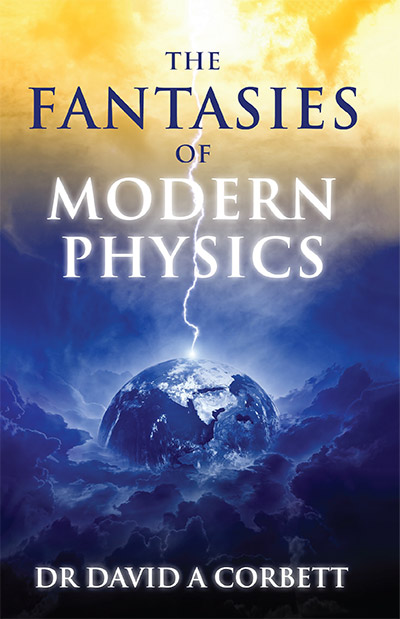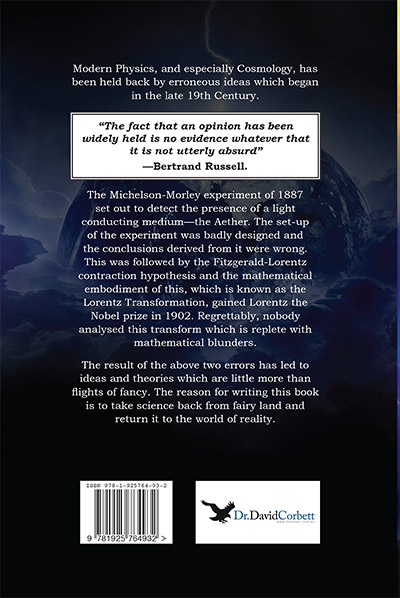The Fantasies of Modern Physics
$15.00
At the beginning of the 20th century, Einstein
captivated the scientific world with his Special and General
Theories of Relativity. Even though he made postulates
that have never been satisfactorily proved, a large industry
has developed to investigate these postulates. Because so
much money is now involved, the scientific world has no
interest in publishing any facts that would prove Einstein
wrong.
Description
Part -1
Time: Einstein postulates that time slows under two conditions—with increasing speed or with increasing gravity.
Time, by definition, is constant. When the sun makes two successive transits over the Greenwich meridian, a solar day has passed. Hours, minutes and seconds are all defined as sub-units of that solar day. All of our clocks – even the most accurate Caesium atomic clocks – are calibrated
according to the rate of rotation of the earth. If your clock reads 4:15 and the sun is directly overhead, I can state without any fear of contradiction that your clock is wrong.
To alter the rate of the passage of time, we would have to alter the rate of rotation of the earth. How can any mass with a high gravitational force, or a traveller approaching the speed of light in the outer reaches of the universe alter the rate of rotation of the Earth? If the earth did alter its rate of rotation in response to every individual travelling at different speeds, we would all be scrambled eggs!
Part 2
There possibly are Doppler red and blue shifts, but the postulate that all red shifts are proportional to velocity of recession must be wrong. Another fact that puts lie to the Doppler hypothesis is that stars are not getting dimmer. The intensity of light from any light source decreases with the
square of the distance between the source and the observer. Thus receding stars should be getting dimmer with time. Are they? No! Further, if Red shifts are due to stars moving away and increasing their velocity of recession, then the Red shift of such stars must be continually increasing. Is
this so? No!
There is an explanation for the fact that distant stars have greater red shifts than the nearer ones, but that involves accepting that the velocity of light is not constant. We know that red light travels faster through air and water than does blue light. It therefore seems reasonable to accept that red light might also travel faster through space than blue light. If this is so, we would expect to see a greater preponderance of red light from stars that are further away.
Consider the analogy of two troops of soldiers running past us—one troop having red coats and the other having blue coats. Let those with red coats be running at twice the speed of those with blue coats. If we were close to the start of their run, we would not notice much difference in the numbers running past us. However, the further away from the start we were, the greater number of red coats would pass us compared with blue coats (assuming our soldiers were innumerable, perfect athletes and could run forever without respite).
Part 3
As a result of the knowledge of the mathematics of wave transmission along a string (the one-dimensional wave equation), it was felt that the transmission of a wave motion as fast as that of light would require the transmitting medium to have the following characteristics:
It would have to be elastic,
It would have to have enormous tension and
It would have to have a very low density.
Generally, we find it hard to conceive of such a medium.
If we think of steel, it has a high tension but it also has a high density. Similarly with paper—it has a low density but also a low tensile strength. But consider an elastic rope with a steel bob on the end.
If we spin this apparatus around our head, the centrifugal force of the bob will stretch the elastic rope. Hence, we have a situation of a rope that is increasing in tension as it decreases in density (the rope gets longer but its mass does not increase. Hence the mass per unit length decreases).
If we look into the cosmos, what do we see? Everything is spinning! Descartes originally postulated a vortex theory of the universe. This theory was popular for some time but fell out of favour for various reasons. Perhaps now is the time to revisit that theory.
Michelson postulated that if the luminiferous ether had the characteristics required for the speed of transmission of light i.e. low density and high rigidity, then the motion of Earth through space should experience an “ether wind”. He devised an experiment to detect this “wind” but this
yielded negative results. The experiment had numerous flaws which are discussed elsewhere (see The Michelson-Morley Experiment) but the conclusion reached was that there was no light conducting medium.
In fact, there is abundant evidence to suggest that there is such a light- conducting medium. Any wave motion requires a medium to transmit it and as light is a wave motion, it also requires a transmitting medium. What was previously known as the “ether”, I call this transmitting medium, the matrix of the universe.
Available at :
*Price may vary by retailer
Get a FREE ebook by joining our mailing list today!
Lorem ipsum dolor sit amet, consectetur adipiscing elit.







Reviews
There are no reviews yet.